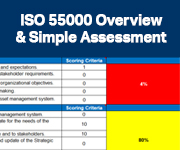Corrective Action for ISO 55000
By Brian Kaiser, Life Cycle Engineering
How to drive continual improvement through an impactful Corrective Action program
At its core, the Corrective Action (CA) process addresses issues or gaps that have been identified, develops a complete action plan to address those issues or gaps, and resolves them completely and verifiably. The CA process should be rigorous, consistent, repeatable, and accommodate a wide range of uses. Using a methodical approach, a CA process:
- Clarifies the roles and responsibilities for executing on continual improvement
- Sets realistic targets and expectations for improvement activities
- Verifies that the expected results are gained and makes corrections as needed
- Documents the benefits gained in continual improvement
Reading clause 10.2 (Nonconformity and Corrective Action) of ISO 55000 should feel familiar to any ISO 9001 practitioner. The ISO 9001 standard has created a good benchmark for what a CA program should look like, and the structure of clause 10.2 follows the same five steps of the process:
- Identify the issue and take controlling action to mitigate immediate consequences
- Determine the root cause(s) of the issue
- Develop an action plan to address the root cause(s) and implement
- Verify that the action plan was executed and validate that the root cause(s) were addressed
- Make changes as necessary to prevent reoccurrence of the issue
While similar to how ISO 9001 approaches CA, ISO 55000 expects a larger scope, with more than just “nonconformances” being addressed by the process. For an organization pursuing asset management and ISO 55000, the scope should include any process in the organization that generates issues to be resolved or gaps to be closed. Therefore, corrective actions can originate from many sources including Root Cause Analysis (RCA) recommendations, unfavorable variances in performance indicators, and internal gap audit findings.
To make corrective action truly effective in maximizing execution on continual improvement, pair it up with a well-developed RCA process. RCA is an effective tool for looking beyond the symptoms of a problem to the true causes, and those findings and recommendations can become corrective actions that the CA process carries through to completion. The verification and validation step of the CA process ensures that the action plan properly addressed the root causes from the RCA, and if not, revisiting the RCA will help to get to the true root causes. Learn about our ISO 55000 Training for Leaders, a one-day virtual workshop.
Brian Kaiser is an ISO 55000 Subject Matter Expert at Life Cycle Engineering (LCE) with more than 10 years’ professional experience in the electric utility industry. You can reach Brian at bkaiser@LCE.com.

